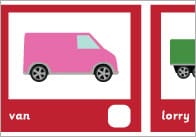Communication, Language and literacy: Planning your learning environment
It is important that you keep in mind the language, literacy and communication goals when planning your learning environment. Always ensure that there is sufficient writing paraphernalia within reach for emergent writing to be practised.
Different types of paper should always be available as well as biros, pencils and felt pens. We have many different types of themed notepaper which can be useful to inspire children in their work/play. Boxes and containers should be labelled with the relevant word and picture. Captions to friezes are more effective at the bottom where children can read and even touch them. Display important messages such as “Please look for Harry’s train – he has lost it” on a notice board and make use of illustrated labels to give instructions e.g. “4 can play with the sand”. Popular rhymes and songs could be displayed at child height or made into books for children to read.
Make the book corner inviting by ensuring that the covers of books can be seen and that there is comfortable seating for children to enjoy books individually or with an adult. Ensure that there is a broad selection of story and factual books and that they promote positive images of culture, disability, gender, and different languages. You may find it useful to ask the advice of parents about new resources for your setting. This will help you to choose resources that are culturally appropriate and It will also help parents to feel a sense of ownership of the setting.
Avoid the use of continuous background noise / music. This can be distracting for young children and can inhibit communication. “Children who are in the early stage of language development need to learn how to tell the difference between the sounds that make up language and other sounds around them” (Every Child a Talker: Guidance for Early Language Lead Practitioners).
The outdoor area is equally as important as the indoor environment when it comes to promoting language, literacy and communication skills. Ensure that you have outdoor reading and mark making areas and try to include interesting posters and friezes. Why not print and laminate some of our literacy or numeracy resources. Our sister site www.poster-play.co.uk sells large format, laminated versions of most of our resources which are ideal for outdoor displays. They also sell many role-play backdrops which are perfect for outdoor play and which contain many keywords which will reinforce children’s learning.
Create a designated talking space / den within your learning environment, positioned away from noisy areas. Often children feel more secure in small, well-defined areas. Include posters and props that encourage children to talk amongst themselves and develop their imaginary play. The following series of small world posters are ideal. Make sure that any seating is arranged so that the children are facing each other rather than being in a straight line. This will make it easier for them to communicate. It is important to create an environment that provide opportunities which excite and stimulate children and make them want to communicate with others.
Finally, it is important to remember that creating an effective enabling environment isn’t just about the building and the resources available. It is as much about the way in which adults interact, play, listen and communicate with the children. The government’s Every Child a Talker publication gives the following top tips for practitioners which may be useful to note in this context:
Use gestures and visual clues to support spoken language.
– Talk about things in the ‘here and now’, e.g. things that you can see and hear.
– Use simple language and pronounce words clearly.
– Repeat words and phrases often.
– Give children time to respond.
– Emphasise key words and information.
– Small-group work can support language and social skills and build confidence.
You may find the following books useful in planning your learning environment:
The Little Book of Outdoor Play: Little Books with Big Ideas (Little Books)
The Little Book of Mark Making: Little Books with Big Ideas (Little Books)
The Little Book of Props for Writing: Little Books with Big Ideas (Little Books)
The Little Book of Writing: Little Books with Big Ideas (Little Books)
Popular Teaching Resources
Stay Up To Date
Sign up for our newsletter and we’ll let you know when we create new early years resources.





